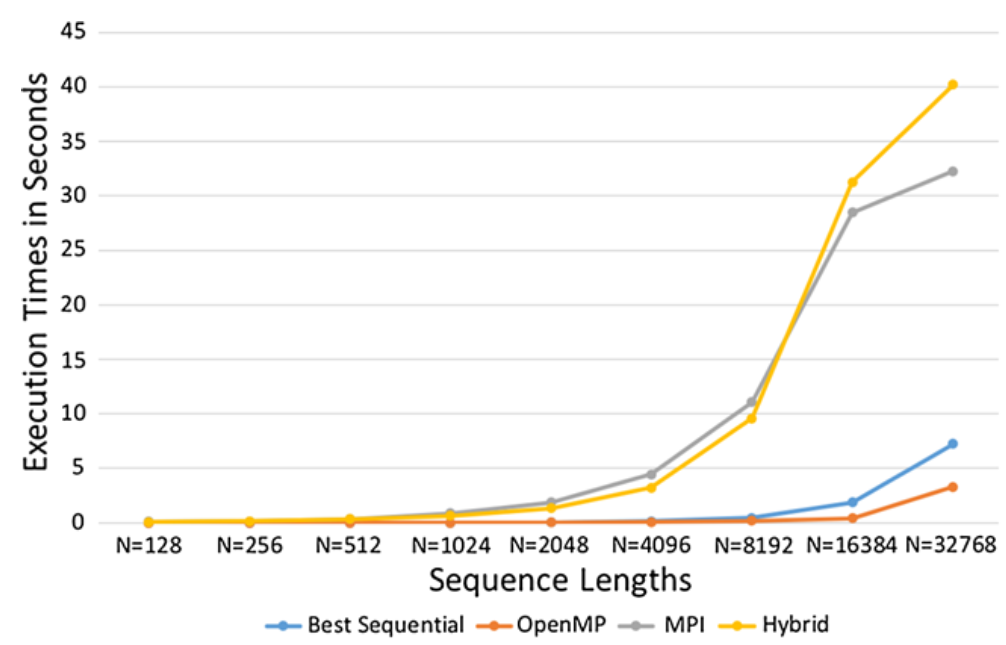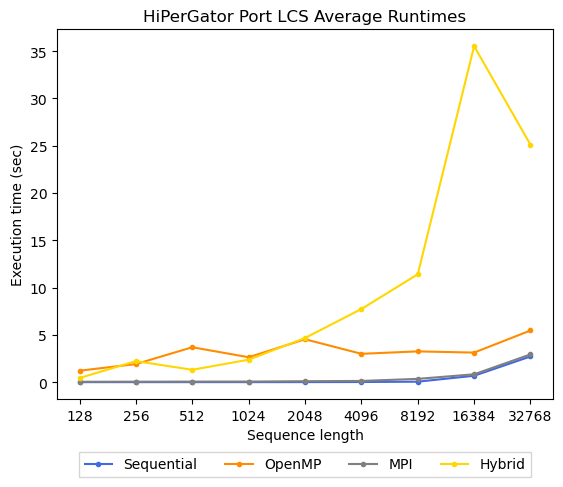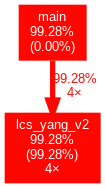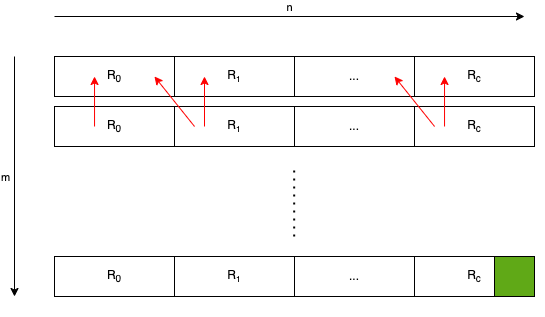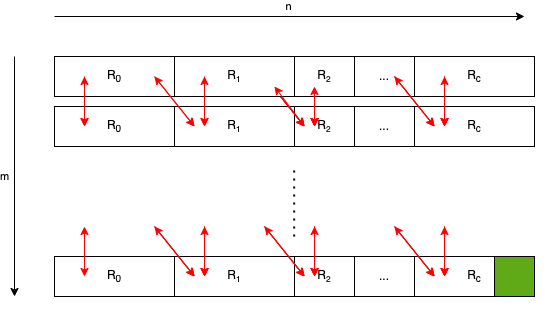This project ports multiple implementations for a parallelized LCS aglorithm to the HiPerGator computing platform to reproduce results, profile the program, and experiment with code modifications that improve the run-time performance specifically for the HiPerGator computing platform.
Finding the longest common subsequence (LCS) in general is an NP-hard problem that has applications in pattern recognition, data compression, and DNA sequencing. To improve practical performance in computing the LCS, Yang et al. designed and implemented a row- wise independent version of the dynamic programming approach that removed current row data dependencies with the current row itself [1]. In this project, we focused on analyzing existing implementations of the parallel LCS algorithm for DNA sequencing for HPC systems ported to the HiPerGator computing platform to identify performance bottlenecks and optimize the MPI implementation in terms of space efficiency and execution time. By localizing processing and localizing communication through a concept called neighbor distance, we created a highly scalable, space-efficient, robust, and optimized MPI implementation that saw as much as 9.091x improvement over the best published implementation (OpenMP) and as much as 8.495x improvement over the best ported implementation with scaling (OpenMP) on HiPerGator.
Porting the application required no code modification as the applications used compatible versions of MPI and OpenMP available on the HiPerGator computing platform. Regarding resource configuration, separate job scripts were created according to the original mapping of resources outlined in the existing repository with respect to the class resource constraints.
We used the same simulated data files for the experimental trials of varying sequence lengths. Without modification of the resource configuration, we ran the applications 4 times and averaged the results. For all experiments, we used the space optimized version 2 of the algorithm, which does not include branching.
To replicate the results and port to HiPerGator, we compiled the source code for MPI and OpenMP respectively using the available tools on the HiPerGator platform, and then translated the available SLURM scripts to SLURM scripts compatible with the HiPerGator resource constraints.
| Data File | Sequence Length | Execution Times (sec) | Average Time (sec) |
|---|---|---|---|
| 1 | 128 | 0.000371 0.000023 0.000371 0.000020 0.000017 0.000015 0.000016 0.000018 0.000017 0.000015 | 0.0001 |
| 2 | 256 | 0.000441 0.000049 0.000049 0.000049 0.000046 0.000064 0.000062 0.000048 0.000050 0.000064 | 0.0001 |
| 3 | 512 | 0.000207 0.000207 0.000203 0.000198 0.000201 0.000206 0.000204 0.000205 0.000199 0.000201 | 0.0002 |
| 4 | 1024 | 0.000779 0.000853 0.001245 0.000796 0.000869 0.000905 0.000810 0.000938 0.000801 0.000814 | 0.0009 |
| 5 | 2048 | 0.002980 0.002948 0.003000 0.002997 0.003033 0.002953 0.003064 0.003038 0.002962 0.002958 | 0.0030 |
| 6 | 4096 | 0.012194 0.011941 0.011916 0.012104 0.011995 0.011965 0.012476 0.012556 0.012582 0.011893 | 0.0122 |
| 7 | 8192 | 0.049810 0.049226 0.049130 0.045651 0.049054 0.049443 0.048955 0.049533 0.048858 0.046275 | 0.0486 |
| 8 | 16384 | 0.231989 0.233137 0.786195 0.789942 0.782391 0.776745 0.784816 0.778986 0.786684 0.788419 | 0.6739 |
| 9 | 32768 | 2.606464 2.605415 2.609088 2.604304 2.797391 2.868034 2.777950 2.811413 2.661989 2.796924 | 2.7139 |
This resource configuration used 4 MPI ranks, with 1 node per rank.
| Data File | Sequence Length | Execution Times (sec) | Average Time (sec) |
|---|---|---|---|
| 1 | 128 | 0.019729 0.022177 0.03823 0.056542 0.048627 0.032777 0.053743 0.044773 0.028842 0.046976 | 0.0392 |
| 2 | 256 | 0.026766 0.06133 0.072586 0.059328 0.026465 0.038507 0.062153 0.043889 0.030711 0.06052 | 0.0482 |
| 3 | 512 | 0.063678 0.035605 0.058359 0.080986 0.093693 0.045625 0.053005 0.055674 0.033691 0.050643 | 0.0571 |
| 4 | 1024 | 0.045182 0.053157 0.074414 0.082618 0.059639 0.061575 0.06521 0.059162 0.06607 0.056574 | 0.0624 |
| 5 | 2048 | 0.10042 0.109785 0.156331 0.092311 0.081484 0.090192 0.077452 0.121056 0.091945 0.072413 | 0.0993 |
| 6 | 4096 | 0.115745 0.137244 0.122812 0.114469 0.127335 0.134278 0.137722 0.141049 0.115973 0.113538 | 0.126 |
| 7 | 8192 | 0.263248 0.371826 0.295419 0.322134 0.325134 0.315329 0.344122 0.41915 0.438704 0.366474 | 0.3462 |
| 8 | 16384 | 1.033553 0.697195 0.626562 0.800125 1.0532 0.875816 0.836243 0.714566 0.778922 0.871328 | 0.8288 |
| 9 | 32768 | 2.878253 2.999817 2.994717 3.254026 3.261782 3.206938 3.324159 3.245434 2.06097 2.098348 | 2.9324 |
This resource configuration used 16 HW threads, with 1 SW thread (OMP thread) per HW thread.
| Data File | Sequence Length | Execution Times (sec) | Average Time (sec) |
|---|---|---|---|
| 1 | 128 | 1.365148 1.733693 0.524365 1.392096 1.455715 1.361408 0.125524 1.514258 1.253844 1.376699 | 1.2103 |
| 2 | 256 | 2.750452 2.291662 1.85998 0.294436 2.749336 1.773968 2.716889 1.015483 0.908677 2.737538 | 1.9098 |
| 3 | 512 | 2.537857 2.109428 5.460088 0.956158 2.448417 0.751005 5.543553 5.649377 6.033497 5.400465 | 3.689 |
| 4 | 1024 | 0.094235 0.070896 0.042511 0.032957 0.031723 0.413642 5.214807 2.950355 5.294654 12.166126 | 2.6312 |
| 5 | 2048 | 1.155797 3.123122 2.056894 0.603369 1.065944 11.809286 2.302476 13.890807 8.992258 0.334972 | 4.5335 |
| 6 | 4096 | 1.460431 4.015968 0.349657 1.887938 14.856938 2.73253 0.050808 1.668156 1.53982 1.37705 | 2.9939 |
| 7 | 8192 | 2.902658 1.458237 4.955549 0.697717 0.93535 7.98361 7.214968 0.653267 1.848592 3.852805 | 3.2503 |
| 8 | 16384 | 0.619363 1.797766 3.570588 3.200398 1.516538 0.412951 2.783114 2.611429 13.890023 0.820922 | 3.1223 |
| 9 | 32768 | 2.283845 8.130311 1.241325 9.216436 1.324067 3.544851 10.520482 1.168947 15.430236 1.728614 | 5.4589 |
This resource configuration used 4 MPI ranks, with 1 node per rank, along with 8 HW threads with 2 SW threads (OMP threads) per HW thread. Therefore, there was a total of 16 threads per MPI rank. We tried to push as much as the threading to the HW level as possible.
Expected Output: lcs_parallel/Experimental Codes/hybrid/row_wise_v2/output.txt
chunk_p: 1 chunk_dp: 8192 procs: 4
lcs_yang_v2 is: 9793
time taken for lcs_yang_v2 is: 84.181711
Received Output:
Your input file: /home/c.ruskin/eel6763/project/data/9.txt
chunk_p: 1 chunk_dp: 8192 procs: 4
lcs_yang_v2 is: 9793
time taken for lcs_yang_v2 is: 18.410843
| Data File | Sequence Length | Execution Times (sec) | Average Time (sec) |
|---|---|---|---|
| 1 | 128 | 1.160284 1.531648 0.266275 0.548088 0.239805 0.072323 0.081891 0.069805 0.190384 0.218161 | 0.4379 |
| 2 | 256 | 0.197626 0.279324 4.668157 0.387672 6.462353 1.484835 2.844701 2.042940 0.765231 3.072877 | 2.2206 |
| 3 | 512 | 0.985455 0.188529 0.471908 6.271154 0.614593 0.178996 0.180045 0.476519 3.201555 0.483542 | 1.3052 |
| 4 | 1024 | 4.340137 0.450255 2.220740 0.643680 0.143427 6.914408 0.092973 0.107141 0.356598 8.466495 | 2.3736 |
| 5 | 2048 | 9.384179 0.374571 25.842704 0.329829 1.708575 0.129476 0.255980 0.462912 6.919479 1.233732 | 4.6641 |
| 6 | 4096 | 0.270917 31.765062 0.432005 0.249861 0.299286 0.377718 7.341979 11.498047 24.888295 0.156566 | 7.728 |
| 7 | 8192 | 5.060595 1.489765 19.549317 4.812395 15.354794 22.566437 7.644825 2.059040 25.541811 9.915244 | 11.3994 |
| 8 | 16384 | 65.547007 7.618724 6.521599 9.759822 40.410821 29.455607 74.468613 66.034749 36.462286 18.877345 | 35.5157 |
| 9 | 32768 | 5.878036 49.894558 21.904620 5.441529 7.181469 7.785590 16.857561 40.137565 23.011245 72.876006 | 25.0968 |
The following table approximates the recorded measurements referenced in the paper's graph (Figure 2 (a)).
| Data File | Sequence Length | Sequential (sec) | MPI (sec) | OpenMP (sec) | OpenMP+MPI (sec) |
|---|---|---|---|---|---|
| 1 | 128 | ~0 | ~0 | ~0 | ~0 |
| 2 | 256 | ~0 | ~0 | ~0 | ~0 |
| 3 | 512 | ~0 | ~0 | ~0 | ~0 |
| 4 | 1024 | ~0 | 1 | ~0 | 1 |
| 5 | 2048 | ~0 | 2.5 | ~0 | 2 |
| 6 | 4096 | ~0 | 5 | ~0 | 4 |
| 7 | 8192 | 0.5 | 11 | ~0 | 10 |
| 8 | 16384 | 2 | 28 | 0.5 | 32 |
| 9 | 32768 | 7 | 33 | 4 | 40 |
The graphical results of our experimental porting of the application to the HiPerGator are provided below.
We proceeded with using the MPI version of the code to identify potential bottlenecks in increasingly large data sets. We used gprof to measure the time for each function.
Using gprof did not reveal much information because the application is fairly linear in its process to distribute work and begin computing the tasks in parallel for yang's LCS algorithm. Even breaking the steps of the algorithm into separate functions, gprof was not able to identify enough samples to calculate timings in the different regions of code.
To try to gain more insight, we implemented custom profiling throughout the stages by using a timing function for the wall time and enabling a configuration variable #define PROFILE 1. Our analysis of the application identified the algorithm running m iterations independently on the allocated ranks, with a large amount of communication occurring between ranks during each iteration to synchronize the partially computed R matrix across all ranks for the next iteration. Each rank depended upon values computed in the previous iteration, but never values in the current row (hence, Yang's algorithm is called row-wise independent).
In the original approach, the program used MPI_Allgather(...) to distribute the computed section of each rank to all other ranks and then collect the computed sections of all other ranks to maintain the previous R matrix row as the m iterations progress.
Analyzing the available workloads, we identified a pattern: for a given iteration, a rank's dependencies can be limited to only requiring its previously computed section from the last iteration and its left neighbor's section from the last iteration. We call this the neighbor distance of a rank, and it can be configured using the compile-time variable #define NEIGHBOR_DIST 1. Additional logic is implemented to check and exit early during computation if a rank requires data from a neighbor that is further away than the configured amount. However, given a very large n and a limited number c of ranks (maximum: 32), it is common for a rank to only require the data of the immediate neighbor that is 1 allocation away from the current rank.
With this new approach, the communication among ranks is greatly reduced by only speaking between neighbors to the left and right using MPI_Send(...) and MPI_Recv(...) up to neighbors that are NEIGHBOR_DIST away from the current rank. This reduced communication time is seen on every of the m iterations.
Because only partial entries of the previous R matrix is needed for each rank, then we can also optimize the space required for a given rank by limiting to only the total number of entries stored for the current ranks's distribution of work as well as its neighbor's distribution of work. No longer is the entire R matrix of size n needing to be communicated and maintained across ranks, only the necessary partial sections.
The result for the LCS algorithm is computed in rank c in the final entry of the last iteration m. This result is then sent to the root rank (rank 0) to synchronize the result with the main process.
With the new improvements to minimized communication cost, we can scale the number of ranks without introducing significant additional communication costs per rank. Therefore, we found the ideal resource configuration to be the maximum allowed ranks: 32. We suspect improvements in execution time to continue for larger size of ranks due to the nature of the communication between only local ranks.
There were numerous other bugs and small code modifications implemented to improve the program.
We further took our improved MPI version and ran it on even larger inputs.
We tested our improvements against the original MPI implementation using the suggest resource configuration using a dataset (Length A = 131072, Length B = 131071, Length C = 4).
Original MPI:
lcs_yang_v2 is: 127963
time taken for lcs_yang_v2 is: 50.016128
Original OpenMP:
lcs_yang_v2 is: 127963
total time taken: 3.916268
Improved MPI:
LCS: 127963
Execution time: 1.884260
For this input, the calculated speedup is roughly 26.6x faster than the original implementation.
For real data 9.txt, the original work's best implementation (OpenMP) took roughly 1 hour according to the graph. The original MPI version took over 7 days to complete. Our improved MPI version had the following result:
Improved MPI:
Loading DNA file "/home/c.ruskin/eel6763/project/data/r9.txt" on each of 32 processes (1 threads per rank)...
Branching: disabled (version 2)
Length of string B: 3078061
Length of string C: 4
String C is: ATCG
LCS: 1274453
Execution time: 840.397835
For this input, the calculated speedup is roughly 4.28x faster than the best original implementation.
For real data 10.txt, the original work's best implementation (OpenMP) took roughly 10 hours according to the graph. The original MPI version took over 7 days to complete. Our improved MPI version had the following result:
Improved MPI:
Loading DNA file "/home/c.ruskin/eel6763/project/data/r10.txt" on each of 32 processes (1 threads per rank)...
Branching: disabled (version 2)
Length of string B: 16199981
Length of string C: 4
String C is: ATCG
LCS: 1505370
Execution time: 3966.671467
For this input, the calculated speedup is roughly 9.00x faster than the best original implementation.
[1] https://www.iaeng.org/publication/WCE2010/WCE2010_pp499-504.pdf
[2] https://www.ncbi.nlm.nih.gov/pmc/articles/PMC6458724/
[3] https://github.com/RayhanShikder/lcs_parallel
